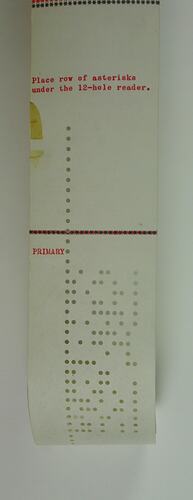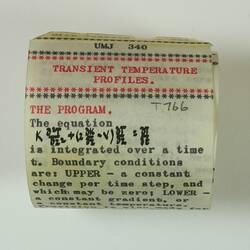In 1956 Martin James Ditmar 'Dick' Jenssen completed his B.Sc. course at the University of Melbourne, majoring in Physics, and was fortunate enough to be accepted as a Masters candidate with the Meteorology Department. He was to be supervised by Dr. Uwe Radok. Dick Jenssen was an avid fan of science fiction, and since the research topic was the development of a weather forecast using the digital electronic computer CSIRAC, he felt as though he would be living a science fiction story. The program was based on The Barotropic Model - a simplified set of equations governing the behaviour of the atmosphere and which allowed a prediction to be made of the weather using an electronic digital computer. Australian scientists at CSIR (Council for Scientific and Industrial Research - later to become CSIRO) had built the world's fourth computer which had its programs, and data, stored internally in its memory. CSIRAC, as the computer was now called, had just been installed within the Physics Department.
The Barotropic program, modified for the Southern hemisphere, specifically for the Australian region, required two hours of CSIRAC time to produce a 12-hour forecast, so a full day's prediction would mean two such runs. Unfortunately, CSIRAC was not as reliable as present-day technology, and would make a random error roughly every twenty minutes or so. Although working all night, usually once a week, it took many months for a 24-hour forecast to be eventually produced in mid-1958. This forecast was the first ever made in the Southern hemisphere. Further work by Radok and Jenssen used the model - by hindcasting backwards in time - to identify areas where more observational data were needed for future forecasting, if such prognoses were to be highly successful. They were also able to show that this simple model implied highly realistic distributions of thermodynamics and vertical motions, and how it could even be used to predict rainfall distributions.
The head of the Meteorology Department was Dr. Fritz Loewe who was also a glaciologist: he had wintered in Greenland with Alfred Wegener in 1930-31. Since Radok's research interests also included glaciological concerns, it was inevitable that Jenssen would be steered toward this area. With his experience with CSIRAC Jenssen would pioneer the use of computer techniques to determine the temperature distribution within large ice masses, both for steady states (when the ice is relatively stagnant) and transient states (when the ice has a significant velocity). When snow falls on the ice surface, its temperature reflects the climatic temperature prevailing at deposition. As further snow falls, these temperatures are driven into the ice and are, so to speak, fossilized therein, so that the theoretical temperature determinations, compared to those actually observed, are a method of determining past climatic change. These studies formed a major part of Jenssen's Ph.D. work, under the supervision of Dr. Radok.
This work continued until 1963 when Dr. Jenssen left to take up a position with the Meteorology Department of the University of Wisconsin in the US. On his return, CSIRAC had been retired.
Dick Jenssen is a founding member of the Melbourne Science Fiction Club. The Australian Science Fiction Achievement Awards, given yearly at National Conventions, are popularly known as 'Ditmars' after him.
More Information
-
Keywords
-
Authors
-
Article types

